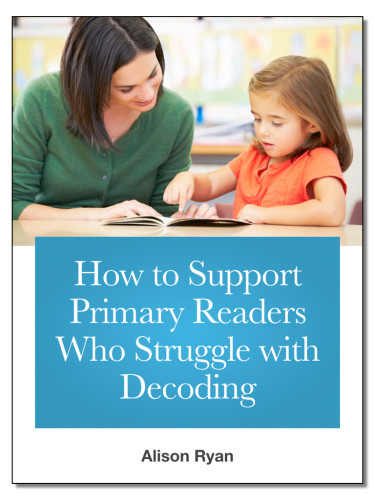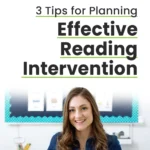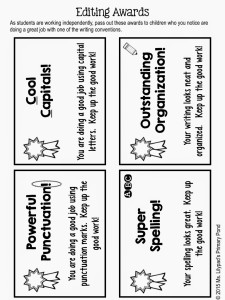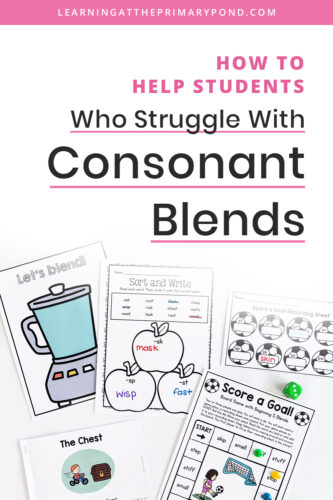During the past month, I’ve shared lots of different ways to help students who struggle with decoding. I’ve discussed causes of decoding difficulties, how to figure out what students need by using running records, how to teach decoding strategies to beginning readers, phonological awareness interventions, and phonics interventions.
All of this stuff is important. But do you know what’s even more important? Giving struggling readers plentiful opportunities to practice real reading.
Because no matter how good your phonemic awareness activities and phonics games are, struggling readers aren’t going to become successful readers without practice time – and lots of it.
In today’s post, I’ll suggest ways to make more time for reading practice, or volume reading (reading a lot). I’ll also address common barriers to independent reading time and provide ideas for overcoming them. At the end of the post, I’d love it if you’d contribute your own ideas in the comments!

Ways to Make More Time for Reading Practice
In your classroom, reading practice can take the form of independent reading, partner reading, or guided reading. In each of these activities, students are the ones responsible for doing the majority of the decoding and comprehension. (This is different from a readaloud or shared reading – both are very valuable literacy practice, but the teacher is the one doing the work during these activities.)
Take a minute and total up the number of minutes students spend reading on a daily basis. If you teach Kindergarten or 1st, do students spend 30 or more minutes reading each day? If you teach 2nd, do students spend 40 or more minutes reading?
If not, you’re not alone. It’s really hard to fit in independent reading when there’s SO much you have to cover each school day. When I had a classroom of my own, I struggled with this.
But in order to help your struggling readers (and all your students) get in the practice they need, it’s important to strive for 30-40 minutes of reading time in the primary grades. Here are some suggestions to help you make this happen:
- Break up independent reading time into chunks. I don’t know about your Kinders, but mine sure as heck couldn’t sit and read for 30 minutes! 😮 The same goes for first graders, especially at the beginning of the school year. Start with 5-10 minute chunks throughout the day, and eventually work up to 2 longer blocks (or 1 block, if your students are ready for it).
- Make use of awkward time periods around lunch and specials. If you’ve taught a full hour of math by 11:45 and lunch doesn’t start until 12, make an effort to stop math on time each day and squeeze in 10 minutes of reading. I know that transitions also take up time, especially with the little ones, but why not give it a try? Challenge the class to fit in 10 minutes here or there, and then reward them if they are able to transition quickly enough to do so.
- Replace (some) independent work with reading. Instead of having lots of different phonics or sight word centers, replace a few of them with independent reading and/or partner reading. So that students still get opportunities to practice working with words, try implementing A Weeks and B Weeks. During A Weeks, for example, students can spend a little more time on word work centers. During B weeks, they can spend more of their independent work time reading.
- Differentiate the amount of time that students spend reading. Some kids just need more practice time than others. Are there certain times of the day where your struggling readers are not being productive? For example, can they not complete the morning work because it involves reading text that’s too difficult for them? Have them sit at your table and read books that are at their independent level, and/or books they’ve already read during guided reading – this will be a more productive use of their time.
- Integrate reading with science and social studies content. You can accomplish this by selecting informational texts for your guided reading groups, and/or by devoting part of science or social studies to having students read about a topic. Reading A to Z often has books at different levels on a single topic. And Readworks is an incredible (free!) resource for informational texts at different levels.
It’s also important that students really benefit from the time that you carve out for reading practice. If students are reading texts that are way too hard, then reading practice time is not going to be particularly productive.
I don’t recommend leveling your entire classroom library and forcing students to select only from certain levels. Instead, I like to teach minilessons on choosing just-right books throughout the year. I also make a point to closely monitor what my students are reading, so that I can redirect them if they pick books that are way too hard for them.
I heard Donalyn Miller speak at the Illinois Reading Conference last year, and she shared something she says to a student who is reading a too-hard book. She says something like: “It doesn’t look like you’re enjoying that book. Let me help you find a book you’ll enjoy more.” I loved this because it’s more tactful than saying, “That book is too hard for you.”
When you help students select books, keep in mind that a child’s independent reading level is lower than his instructional level. You’ll want to help him choose books that are just a bit easier than the ones you read with him during guided reading.
Not all texts read during reading practice time should be first reads. Rereading familiar texts is very valuable for building confidence and fluency, particularly for your struggling readers. Here are some ways to make rereading more fun:
- Give students access to “special books” – Provide opportunities for students to practice reading books they’ve already read during guided reading. Treat these books as “special” to up the excitement (because actually, they probably are – you don’t want to lose texts from your guided reading sets!). Allow students to read these books only in a certain center or at a particular table. This will help you a) generate excitement around rereading and b) help prevent losing the books.
- Have students record themselves rereading – Use tablets or laptops to have students record themselves reading. Encourage them to practice reading a text multiple times to get ready for their recording. Allow students to listen back to their recordings and decide if they made mistakes and need to re-record. Then, send the files to their families to enjoy!
- Have students read to younger children – Buddy up with a preschool or Kindergarten class and have your students read to them. This provides an authentic purpose for students to reread a text multiple times – so they’re ready to read to their buddies!
- Try Reader’s Theatre – Find short plays that students can practice and act out. Help students understand the importance of reading and rereading the script so that they are ready for their big performance!
Barriers To Reading Practice
In theory, giving students time to read should be pretty simple. Just let them choose books, give them somewhere to sit, and let them have at it! But you and I both know that it’s not always that easy.
Here are some common obstacles that you may encounter while implementing independent reading in your classroom. These issues may arise with your struggling readers – or with any student! I’ll provide my take on how to solve these problems, but again, I’d love to hear your thoughts in the comments section.
Some of my students “fake read” during independent reading time, or they find ways to avoid reading.
When I find that a student isn’t really reading during independent reading time, I first try to figure out why that’s happening.
Is the child not interested in his books? I’ll spend some time in the classroom or school library with that student, helping him find topics and authors that he’s interested in. I also check in with that child at the beginning of each independent reading period, to make sure that he has books that he’s interested in reading.
Does the child struggle with attention issues? I’ll modify her reading time to allow for a water or stretch break halfway through, or let the child listen to a friend read for a small portion of the time.
Does the child believe that he can’t read? I try to spend some extra “quality time” reading to the child and with the child. I make sure the student has books that are easy for him to read, like texts that he’s read in his guided reading group.
Does the child lack motivation for some other, unknown reason? I always try to develop intrinsic motivation first (helping the child find interesting books and understand the purpose of reading). However, a combination of intrinsic and extrinsic motivation can sometimes be the most effective. So while I’m not a huge fan of reward-based reading programs (like those from Pizza Hut or Six Flags), sometimes they are necessary to help get a child going.
Does the child pick books that are way too hard for her? See below. 🙂
Some of my students always pick books that are way too hard or way too easy for them.
I had suchhhh a struggle with this one year when I was teaching 2nd grade. I had a group of low readers who wanted to read chapter books like their friends, even though they just weren’t ready for them yet.
To solve this problem, I taught some small-group minilessons on how to choose just-right books (we’d done it in a large group, but these kiddos needed to hear it a couple more times!). I also went to the Scholastic book fair near me and bought more books at their independent reading levels. I’d noticed that although I did have some easy books in my classroom, they weren’t always high-interest. Introducing these new books motivated my low students. I also reserved these books for them by discreetly having them “shop for books” in baskets that I only took out when it was their turn to browse.
Despite all my efforts, I still had one little girl who insisted upon reading chapter books that were WAY too hard. She repeated checked out chapter books from the school library and brought them out to read during independent reading time.
I knew that she didn’t want to be different from her peers, and I certainly empathized with that. But I also knew that we needed to find some sort of balance, so that she could actually benefit from independent reading time.
So she and I agreed that a certain portion of independent reading time would be spent reading books that she and I chose together, and then she could use a small amount of the time to “read” her chapter books. She started the school year at a Level F and ended at a Level L, so I think that this compromise was at least somewhat successful!
Some of my students don’t read at home.
So far I’ve only been talking about reading practice at school. And you and I both know that kids’ time at school is limited. So reading at home is important!
I absolutely encourage my students to read at home. I frequently discuss with them the importance of at-home reading. I educate their parents about at-home reading during back-to-school night and conferences. I assign independent reading each night. I allow them to take my books home (read about how to set up a system here). I also make time for them to chat with a friend about their reading when they come in each morning.
However, this isn’t always enough. Some kids have chaotic home lives, spend a lot of time in daycare, or don’t have consistent parental support with reading. No matter how much I try, they’re not able to read at home each night.
And you know what? I let it go.
Because if I don’t let it go, I’ll make myself crazy.
There are things that we can control, and there are things that we can’t. Something I can control (to a certain degree) is the amount of time that kids spend reading in my classroom. So I do the best that I can with that time, try to facilitate at-home reading, and remind myself to BREATHE when a kid tells me they’re not reading at home.
My school administrators don’t allow time for independent or self-selected reading.
Ugh. I’ve been there. And honestly, I tried to find ways around it as much as I could. Because independent reading DOES matter! And letting kids choose their own books (at times) is powerful in terms of motivation.
If you feel like arguing discussing this point with your administrators, check out Richard Allington’s What Really Matters for Struggling Readers. Bringing research to the table can be helpful when you respectfully share your point of view.
But sometimes, like at-home reading, this is also out of our control. In these types of circumstances, I remind myself that I’ll do the best that I can and try not to stress about what I can’t change.
Conclusions
If you’ve been following along through this whole series on struggling decoders, thank you!! If you’ve missed a couple of posts, go back and check them out!
A couple of teachers have mentioned that they’d like to have all the information (and free resources) from this series in one place. So I’ve packaged it all together in an e-book, which you can read on your computer, or in an e-reader app on your phone or Kindle. This way, you can reference all the information without having to come back and find each post individually. You can find the book here:
I hope that these posts have been helpful to you in supporting your struggling decoders! If you have any questions or comments about this series, feel free to leave them in the comments section or reach out to me here: https://learningattheprimarypond.com/contact/. Thanks for reading!
Resources:
Truby, Dana. “10 Questions About Independent Reading.” Scholastic. N.p., n.d. Web. 25 Jan. 2016. <http://www.scholastic.com/teachers/article/10-questions-about-independent-reading>.
*The author of this text is in no way affiliated with this blog – I am referencing her work as a means of explaining and supporting the ideas I set forth in this post.*
Disclosure: An Amazon affiliate link is included in this post.














Love reading your helpful articles. Thanks for sharing them.
Thank you, Joyce! I’m so glad they’re helpful. 🙂 Thanks for your kind words! Alison
Thanks for the toolkit
You’re welcome, Darcy! Let me know if you have any questions about it. 🙂 Alison
You’re information is so amazing! I love reading your posts and getting you emails! I always get ideas to take back to my room!
Thank you, Sara! I am SO glad you’re getting some ideas – that makes me happy to hear! Thanks for reading and commenting!! Alison
Thank you so much for Sharing! I love reading and learning from your posts!
Brandy
You are so welcome, Brandy! I’m so glad to hear that they’re helpful. Thanks for reading and commenting 🙂 Alison
Thanks for the passion of teaching struggling readers…
I look forward to reading and using your materials. I have 5th graders who are anywhere from beginning readers to almost at level. It’s so challenging to try to meet such diverse needs.
Wow, that is a big range, Tammy! I’m glad the posts are helpful!
Alison
thank you so much, i learned a lots from your posts! It really a huge help for my teaching struggling reading readers.